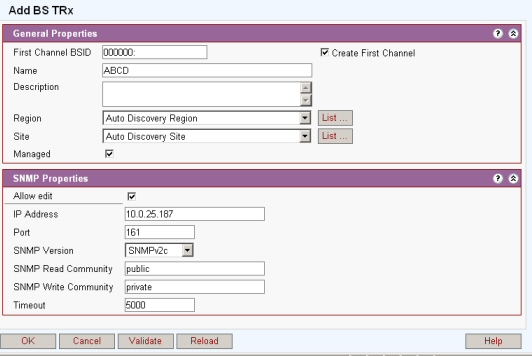

For a discovered BS TRx the following will be displayed. Actual content of bridge and network port sections will vary dependant on BS TRx type and VLAN options
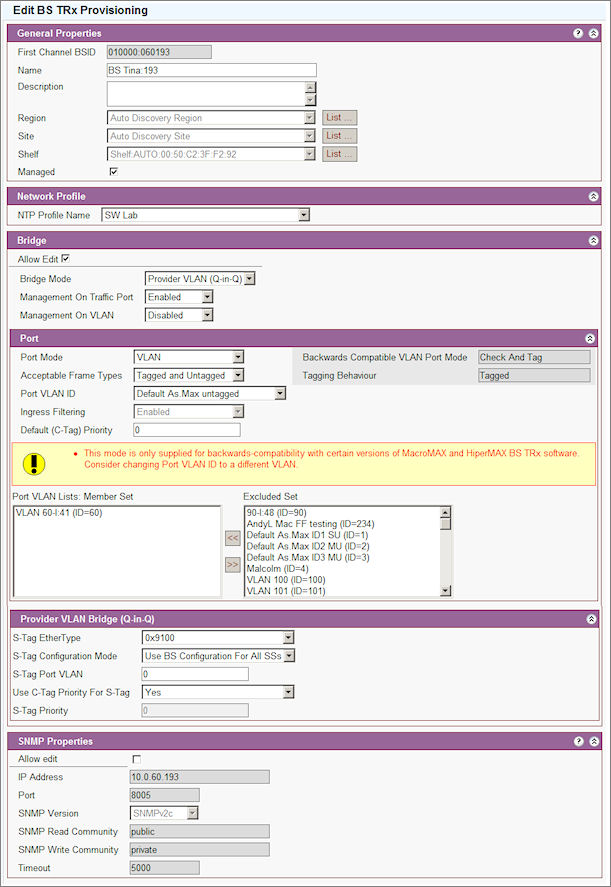
First Channel BSID: BS TRx ID
Create First Channel: Tick (click) if this is the first channel. Add only, this does not appear in edit.
Name: User defined.
Description: User defined.
Region: Select required region. To add a new region see Add New Region
Site: Select required site. To add a new site see Add New Site
Managed: Tick (click) to enable.
Select NTP profile name from drop list
See Alternative VLAN Options below for details of available option by product.
Netspan SR5.0 and above introduced completely new user interfaces for VLAN configuration. The data in existing databases are translated automatically to the new configuration design and the BS TRxs and SSs already in the database will work without interruption. However the default configuration changed for newly discovered BS TRxs.
In Netspan SR5.0 and above the newly discovered BS TRx doesn't have any VLANs associated with its network port but BS TRx can pass traffic to SS. Because BS TRx has default VLAN port mode setting of transparent when it is discovered by EMS server. In contrast the SR3.0 Netspan behaviour was that the newly discovered BS TRxs had its network port configured with all available VLANs in the Netspan database.
Allow Edit: Check this box to enable all controls in this section.
Bridge Mode: choose either 'VLAN', 'Provider VLAN (Q-in-Q)' or 'Not Set'.
Management On Traffic Port: Choose either Disabled or Enabled. Not an option on MicroMAX.
Management On VLAN: choose either Disabled or Enabled.
Management on VLAN ID: This is displayed if 'Management On VLAN' is enabled.Select VLAN ID from list of available IDs.
Port Mode: Set either Not Set, Transparent or VLAN
Acceptable Frame Types: Choices are 'Tagged and Untagged', 'Untagged Only' and 'Tagged Only'.
Port VLAN ID: VLAN ID used for tagging of untagged frames when 'Acceptable Frame Types' is either 'Tagged and untagged' or 'untagged only'
Ingress Filtering: Defines behaviour for port ingress.
Default (C-Tag) priority:Priority used when frame is tagged with Port VLAN ID.
Info Panel: Backwards compatible VLAN Port Mode,Tagging Behaviour are for information only and cannot be set.
Select and use << and >> to include and exclude VLAN in the port member set.

The IEEE 802.1Q-in-Q VLAN Tag is purpose to expand the VLAN space by tagging the tagged packets, thus producing a "double-tagged" frame. The expanded VLAN space allows the provision certain services, such as Internet access on specific VLANs for specific customers, and yet still allows the service provider to provide other types of services for their other customers on other VLANs.
S-Tag EtherType: Q-in-Q encapsulation supports configurable outer tag Ethertype. The configurable Ethertype field values are 0x8100 (default IEEE 802.1ad), 0x9100, 0x9200 and 0x9300.
S-Tag Configuration Mode: Select 'Use SS Configuration' or select 'Use BS Configuration For All SSs'.
Use C-Tag Priority For S-Tag: Select 'Yes' or 'No'. If 'Yes' selected then the 'Default C-Tag Priority' set in 'Port' is used.
S-Tag: If 'Use C-Tag Priority is set to 'No' then set 'S-Tag Priority'.
Allow edit: Check this box to enable access to all controls in this section.
IP Address: IP address of Ethernet connection.
Port: SNMP port number.
SNMP Version: Select version.Netspan supports SNMP V2c.
SNMP Read Community: Sets SNMP privacy parameters private/public needed if using SNMP V2c.
SNMP Write Community: Sets SNMP privacy parameters private/public needed if using SNMP V2c.
Timeout: The number of milliseconds that the NMS waits for a response.
Transparent Mode is not available for HiperMAX, HiperMAX-micro, and MacroMAX. For these platforms use 'Transparent' port mode instead.

Bridge Mode = VLAN; Port Mode = Transparent.

Bridge Mode = VLAN; Port Mode = VLAN; Acceptable Frame Types = Tagged Only

Bridge Mode = VLAN; Port Mode = VLAN; Acceptable Frame Types = Tagged and Untagged; PVID not supported (untagged). Available only for HiperMAX, HiperMAX-micro, and MacroMAX.

Bridge Mode = VLAN; Port Mode = VLAN;
Acceptable Frame Types = Untagged Only; e.g.
PVID = 1 < PVID
< 4094 (e.g. 4093)
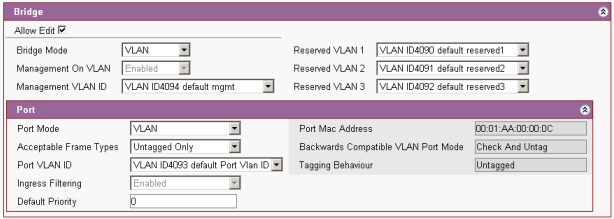
These configurations are for backwards compatibility with MacroMAX, HiperMAX and HiperMAX-micro SR5.0 or older.
Bridge Mode = VLAN; Port Mode = VLAN; Frame Types = Tagged and Untagged; PVID = No PVID.
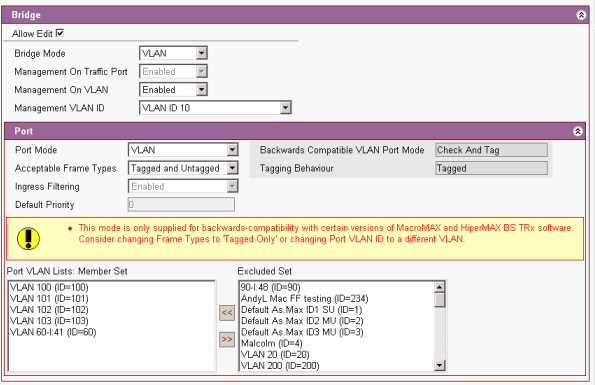
Bridge Mode = VLAN; Port Mode = VLAN; Frame Types = Untagged Only; PVID = 'untagged'.
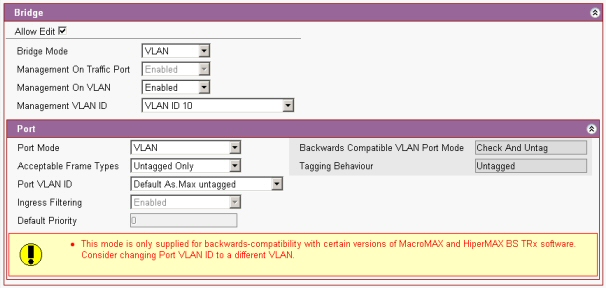
See Action Buttons